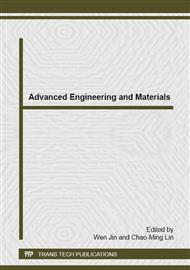[1]
S. Arivoli, M. Thenkuzhali, and M.D. Prasath,. Adsorption of rhodamine B by acid activated carbon – kinetic, thermodynamic and equilibrium Studies., (2009). Orbital the Electronic Journal of Chemistry, 1(2): 138-155.
Google Scholar
[2]
F. Hayeeye, M. Sattar, S. Tekasakul, and O. Sirichote. Adsorption of rhodamine B on activated carbon obtained from pericarp of rubber fruit in comparison with the commercial activated carbon., (2014).
DOI: 10.5004/dwt.2020.26152
Google Scholar
[3]
O. Sirichote, W. Innajitara, L. Chuenchom, S. Panumati, K. Chudecha, P. Vankhaew, and V. Choolert (2008).
Google Scholar
[4]
N. Ninan, Y. Grohens, A. Elain, N. Kalarikkal and S. Thomas (2014) Synthesis and characterization of gelatin/zeolite porous scaffold., Euro. Poly. J. 49, 2433-2445.
DOI: 10.1016/j.eurpolymj.2013.02.014
Google Scholar
[5]
S. Arivoli, and M. Thenkuzhali. Kinetic, mechanistic, thermodynamic and equilibrium studies on the adsorption of Rhodamine B by acid activated low cost carbon., (2007). E-Journal of Chemistry, 5 : 187-200.
DOI: 10.1155/2008/437375
Google Scholar
[6]
B.C. Meikap, T. Naidu, M.N. Biswas, and M. Kaustubha. Removal of crystal violet from wastewater by activated carbons prepared from rice husk., (2006). Ind. Eng. Chem. Res. 45: 5165.
DOI: 10.1021/ie060257r
Google Scholar
[7]
E. Fuente, J. A. Menendez, M. A Dyez, D. Sau'rez and M. A. Montes-Moran. Infared spectroscopy of carbon materials: a quantum chemical study of model compounds., (2003). J. Phy. Chem. B. 107: 6350-6359.
Google Scholar
[8]
S. Senthilkumaar, P. Kalaamani, C.V. Subburamaan, N.G. Subramaniam and T.W. Kang. Adsorption behavior of organic dyes in biopolymers impregnated with H3PO4: thermodynamic and equilibrium studies, (2011). Chem. Eng. Technol. 34(9): 1459-1467.
DOI: 10.1002/ceat.201000535
Google Scholar
[9]
I. Langmuir. Adsorption of gases on plane surfaces of glass, mica and platinum., (1918). Journal of the American Chemical Society. 40: 1361.
DOI: 10.1021/ja02242a004
Google Scholar
[10]
J. Rahchamani, H. Zavvar Mousavi and M. Behzad. Adsorption of methyl violet from aqueous solution by polyacrylamide as an adsorbent: isotherm and kinetic studies., (2011). Desalination. 267: 256-260.
DOI: 10.1016/j.desal.2010.09.036
Google Scholar


